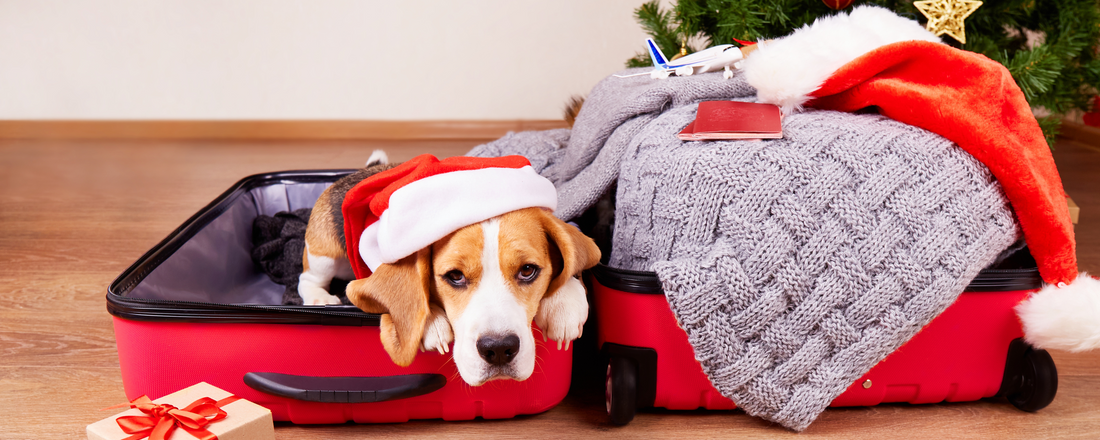The holiday season is here, and while it’s a time of joy and celebration, it can also be a challenging period for pet parents. Many pets experience separation anxiety, a form of distress that occurs when pets feel uneasy or fearful when left alone.
The good news is, with a few simple strategies, you can help your furry friend stay calm and comfortable, even if you’re away celebrating. Read on to learn how to manage mild to severe separation anxiety in pets this holiday season.
What is Separation Anxiety?
Separation anxiety in pets can show up in different ways, from excessive barking and vocalizing to destructive behaviors like chewing and scratching. For some pets, it even leads to escape attempts as they try to reunite with their owners. Recognizing the signs of separation anxiety is the first step toward helping your pet feel more secure and at ease.

Common signs of separation anxiety include:
- Vocalizing (such as barking or whining when you’re away)
- Destructive behavior (chewing on furniture or scratching at doors)
- Escape attempts (trying to dig or break out of confinement)
To better support pets with these behaviors, consider using Paleo Pet Treats designed specifically for anxious pets. Explore Paleo Pet Products to find solutions that may ease your pet's anxiety naturally.
Tips for Managing Mild Separation Anxiety
If your pet shows mild signs of separation anxiety, a method called counterconditioning can work wonders. Counterconditioning involves creating positive associations with your absence, so your pet learns that being alone can actually be enjoyable.

Counterconditioning
1. Introduce High-Value TreatsRight before you leave, give your pet a food puzzle toy filled with high-value treats, like the healthy treats from Paleo Pet. This will keep your pet engaged and provide a positive distraction when you’re not there.
Discover Paleo Pet Treats to find options perfect for this purpose.
2. Remove the Toy When You Return
By removing the puzzle toy upon your return, you reinforce that this special reward only happens during alone time. Over time, your pet will associate your departure with something positive, helping them feel more relaxed when you’re away.
Tips for Moderate to Severe Separation Anxiety
For pets with more intense anxiety, desensitization techniques are often effective. This approach involves exposing your pet to short separations at first, gradually building up their tolerance to being alone.
Desensitization Techniques
1. Manage Predeparture Cues
Pets are highly attuned to signs that you’re about to leave—like putting on shoes, grabbing keys, or picking up a bag. These “predeparture” cues can trigger anxiety in pets.
Training Tip: Try doing these actions without leaving the house. For example, put on your shoes and sit down, or pick up your keys and stay inside for a while. By breaking the association between these actions and your departure, you can reduce your pet’s stress.
2. Gradually Increase Separation Times
Start with brief periods away from your pet and slowly extend the time. For example, step outside for a minute, then come back. Increase this time as your pet gets more comfortable.
If your pet shows signs of severe anxiety, consult a vet to explore solutions like Paleo Pet, which are formulated to support and reduce anxiety naturally. Learn more about Paleo Pet Products for more options.
Creating a Calm Environment for Your Pet This Holiday Season
With the holidays come additional disruptions—more visitors, new decorations, and unusual sounds.

Here are a few more tips to ensure your pet has a calm and joyful holiday:
-
Provide Mental and Physical Stimulation
A well-exercised pet is often a calmer pet. Take them for walks, play with their favorite toys, or try interactive games. Keeping their body and mind active can reduce stress. See our additional tips in the image below for more ideas! -
Create a Safe Space
Set up a cozy, quiet spot where your pet feels secure. This could be a bed in a low-traffic area or a crate they feel comfortable in. -
Avoid Punishment
If your pet shows signs of stress, remember not to scold or punish them. Instead, redirect their attention with toys or activities. This compassionate approach will make a big difference.
Conclusion
Holidays are meant to be enjoyed, and with the right strategies, both you and your pet can make the most of the season. Addressing separation anxiety takes patience, but with consistent effort, your pet will feel safer and more relaxed.
For more insights on pet behavior and wellness, check out Paleo Pet’s Blog—your go-to source for expert tips on pet care. Visit Paleo Pet’s Blog for More Tips.
Helping your pet feel calm, safe, and loved during the holidays is one of the best gifts you can give. Wishing you and your furry family members a joyful, peaceful holiday season!


